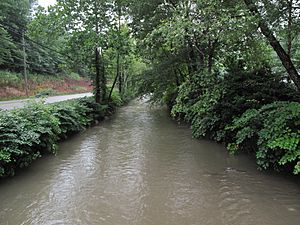Cabin Creek (West Virginia) facts for kids
Quick facts for kids Cabin Creek |
|
|---|---|

Cabin Creek near Ronda
|
|

A map of Cabin Creek and its watershed
|
|
| Country | United States |
| State | West Virginia |
| Counties | Fayette, Kanawha |
| Physical characteristics | |
| Main source | south-southwest of Coalfield 2,311 ft (704 m) 37°58′25″N 81°21′47″W / 37.9737203°N 81.3631638°W |
| River mouth | Kanawha River Cabin Creek 591 ft (180 m) 38°11′56″N 81°28′48″W / 38.1989922°N 81.4801162°W |
| Length | 22.7 mi (36.5 km) |
| Basin features | |
| Basin size | 73 sq mi (190 km2) |
| Hydrologic Unit Code | 0505000602 (USGS) |
Cabin Creek is a stream in West Virginia, United States. It flows into the Kanawha River. A stream like Cabin Creek that flows into a larger river is called a tributary.
Cabin Creek is about 22.7 miles (36.5 kilometers) long. It is part of a larger watershed that includes the Ohio River and the Mississippi River. A watershed is an area of land where all the water drains into a common river or lake. This means water from Cabin Creek eventually reaches the Mississippi River!
Contents
Where Cabin Creek Starts and Flows
Cabin Creek begins in the western part of Fayette County. This is near a place called Coalfield. The creek then flows mostly through southern Kanawha County.
Journey Through Communities
As Cabin Creek travels, it passes through many small towns. These include Republic, Carbon, and Decota. Other communities along its path are Laing, Quarrier, and Holly.
The creek also flows through Leewood, Eskdale, and Ohley. Further downstream are Coal, Giles, and Dawes. Finally, it passes Miami, Sharon, Ronda, and Dry Branch.
Where Cabin Creek Ends
Cabin Creek eventually reaches the community of Cabin Creek. Here, it joins the larger Kanawha River. Roads run alongside the creek for most of its journey. Part of the West Virginia Turnpike also follows the creek.
Why is it Called Cabin Creek?
The name "Cabin Creek" comes from a story from the 1740s. A pioneer's cabin was located near the creek. This cabin was raided by Native Americans. After this event, the creek became known as Cabin Creek.

